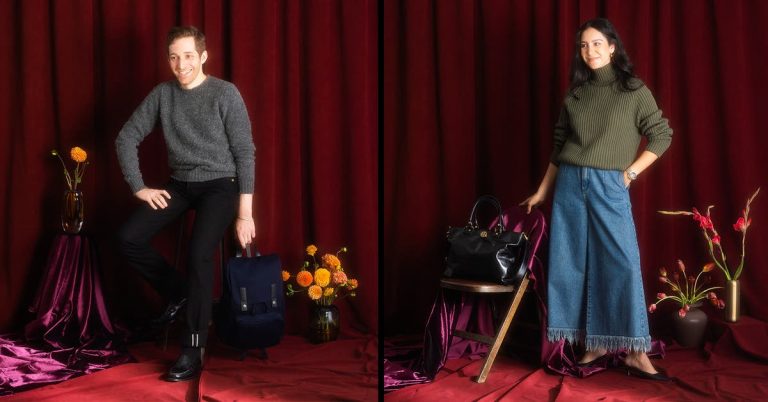The Secrets to Buying Stunning Secondhand Home Decor
Facebook Marketplace has taken over from Craigslist as the first stop for secondhand shopping in someone’s community. One major advantage of Marketplace over Craigslist, which both Ivy and Joshua called out, is that you can get a real snapshot of who the seller is by viewing their listing history and rating. “I found some very cool things on Craigslist for dead cheap that I still have 15 years on, but shopping on it for local finds was always just one big red flag and you had to enter into it hoping for the best,” says Joshua. Facebook’s algorithm-driven platform also allows for a mix of discovery and dedicated searching, since you can play with parameters and search terms, and you’re not limited to searching a single metro area.
So it wasn’t a surprise to learn that Facebook Marketplace was where both Joshua and Ivy started their searches. He was seeking a lamp, and she was looking for a couch. What you find can vary wildly, depending on your location. But there are some things you can do to make your search easier, and many of these tips apply to other online marketplaces, too.
Go broad, use the algorithm — and be patient
Joshua looked within a 60-mile radius of his home in the Hudson Valley, and he did the same 60-mile-radius search around Knoxville and Nashville, Tennessee, where he had a trip planned. He let the distance, rather than specific search terms, dictate his results (and proximity is important when you need to move fast to score a good deal). “I find that even when you’re using specific search terms, you’re often turning up a lot of the same stuff,” he says. So he started out searching “super broad with just ‘lamp,’ since some people might not even realize the lamp they’re trying to unload is a legitimate antique.”
Ivy took the same approach searching for couches on Facebook Marketplace both in New York, where she lives, and Massachusetts, where she spent some time visiting her dad.
Like Joshua, Ivy started broad, with phrases such as “vintage sofa, statement sofa, or even just loveseat, because people often don’t list the brand or designer,” she says. From there, she shifted to current brands and vintage designers, which sellers often call out in their listings, as well as other terms that can help point you in a good direction, such as “estate sale, architect, and designer.” Another search-term trick of Ivy’s is to “misspell things to catch folks’ mistakes.”
Search strategy extends beyond the terms you use, too. Ivy suggests clicking through to see a seller’s other items “if you see anything that is vaguely interesting.” She also notes that you can use Facebook’s algorithm to your advantage, “by saving items you may not actually be interested in but are adjacent to what you’re seeking. For example, saving a Herman Miller light may lead to you seeing more sofas of that period.”
Needless to say, these strategies require patience — and a lot of sifting. “I culled through hundreds of Room and Boards, Restoration Hardware loveseats, and cool patterned vintage affairs,” Ivy says.

And even after dialing down into more specific terms, such as “vintage lamp, vintage floor lamp, and mid-century lamp,” Joshua struggled to find the right lamp.
“I immediately started coming across absurd options, like a light made from a mannequin torso and beaded-fringe hat, complete with drawn-on tattoos and a disco ball outfit,” he says. And thanks to a misguided algorithm, “I even stumbled upon someone selling ’shrooms. The dealer had cleverly separated out the key search word ‘room,’” None of Joshua’s search terms actually included “room,” but Facebook seems to have inserted it into the results, “presumably because a lamp would go in a bedroom/living room/dining room,” he says. Still, “the find felt appropriate, considering secondhand shopping can indeed be a trip, as evidenced by the $75 Homegoods croissant stool and $20 ‘vintage butt’ I found later.”
Zoom in on the photos
The couch that finally caught Ivy’s eye was “a bright mustard Thayer Coggin piece that looked to be in its original upholstery. And it was listed for $900. The pieces in the background signaled to me the seller had excellent taste and a glance at the other items for sale made me realize this was a flash estate sale. I started sweating.”

In particular, Ivy keyed in on the “vintage piano in the background, a neutral color palette, a simple lucite coffee table and what looked like it could have been a sliver of a Nakashima wood chair.” All of these things were indications of the seller’s taste, with a vibe that was “stripped down but had some key nods to classic design pieces.” It turned out those instincts were spot-on: The owner was an architect who had recently moved into assisted living.
Having a keen eye and learning a bit about the seller can also help you source other items. This is a strategy Joshua tried to employ with a rug. “I kept noticing it beneath furniture photos, but when I messaged the shop owner to inquire, he said he liked the rug too much and was holding onto it. I don’t blame him.”

Don’t sleep on Etsy
Though Etsy has a reputation for handmade items, it’s a great place to source vintage. “I found a bunch of EGE Rya wool rugs from the ’70s via Etsy seller MidModGroovy. It was a great collection of unused old stock, and I very nearly bought one with an abstract pattern that looks like witchy tree limbs against a full moon. The image is very on brand for my taste, and I liked that the old stock had slightly different color variations to choose from.”

Cross-check your finds on other sites
Part of what’s difficult is gauging the fair value of items, and that’s where it can be helpful to use the wealth of online listings to your advantage. For example, Ivy located a Ligne Roset “Mama” lamp on Facebook Marketplace that was being sold out of a storage unit in Salem, Massachusetts. “I knew the design and realized how cool it would be to get for this because the arc element retracts into itself, making it possible to use as a standing lamp (in smaller spaces) or extended to any degree desired, with its maximum extension making it a giant arc lamp,” she says.

Before messaging the seller, she did a quick Google search. She found the same lamp listed on 1st Dibs for $2,911 and on Chairish for $3,181 — and a new one has an MSRP of $1,530. All of that made her confident that the price was truly excellent at $300. In fact, a price that low might make you suspicious of the item’s authenticity. But after looking at the seller’s other listings, Ivy felt confident that this deal was not too good to be true. “I had a strong feeling he’d liquidated a showroom and had been selling pieces over time,” Ivy says. And when she picked up the lamp at the seller’s storage unit, she learned she was correct. (After the purchase, Ivy was able to authenticate the lamp with Ligne Roset in France by sending thorough images; this is an option to pursue if you’re seeking confirmation on whether your score’s the real thing.)
This cross-checking process can also be a good way to confirm that what you’re seeing online isn’t just something you could buy on Amazon or Wayfair that’s being passed off as vintage. “I once really liked a rug mixed in with a bunch of true vintage rugs, but when I did a Google image search on that one, I found you could buy the same pattern at a number of major retailers for way cheaper,” Joshua says.
So when he found a rug from Etsy seller Objectmod, with a compact geometric diamond design and no brand markings, he deployed this strategy. “The pattern reminded me of an evil eye talisman, which, like the witchy tree limbs, is extremely on brand for my aesthetic.” It didn’t have any sort of identifying marks on it, so “I did a Google image search to make sure it wasn’t new, and the closest I came to a match was an expired listing for an Hermès bath towel.” While that didn’t tell him much about the rug, it at least confirmed that he wasn’t overpaying for faux vintage, so he bookmarked it as a contender.

Send an interested message, but don’t dillydally on the deal
For both the Ligne Roset lamp and the Thayer Coggin couch, Ivy worked quickly. “This is where vintage furniture shopping becomes a sport. Strategy, athleticism, speed.” And she has a strategy for creating that first message, in order to increase your chances of getting a yes:
- Address people by their first name.
- Say something specific about the piece. (“I’m very interested in this couch, can you tell me a bit about that leg that seems to be askew?”)
- Commit to coming quickly.
- Sign with your first name. (Again, you’re just two people talking, trying to make a deal.)
In the case of the sofa, “I messaged the person and realized the sofa was only 40 minutes from where I was, working remotely while visiting my dad in Massachusetts. And I said I could be there within the hour.” She sealed the deal that afternoon.






